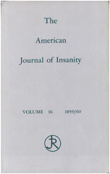Sleep events among veterans with combat-related posttraumatic stress disorder
Abstract
OBJECTIVE: Sleep disturbances are important features of posttraumatic stress disorder (PTSD); however, the published data characterizing PTSD sleep phenomena are limited. The authors report on the phenomenology and physiological correlates of symptomatic sleep events in PTSD. METHOD: The study data included survey results that addressed sleep symptoms during the past month in combat veterans with and without PTSD (N = 58), sleep diary records of awakenings from combat veterans with PTSD hospitalized on an inpatient rehabilitation unit (N = 52), and overnight polysomnography recordings obtained from 21 medication-free combat veterans with PTSD and eight healthy comparison subjects not exposed to combat. RESULTS: Recurrent awakenings, threatening dreams, thrashing movements during sleep, and awakenings with startle or panic features represented the most prevalently reported sleep-related symptoms. Laboratory findings of longer time awake, micro-awakenings, and a trend for patients to exhibit body and limb movements during sleep are consistent with the subjectively reported symptom profile. Prospectively assessed symptomatic awakenings featured startle or panic symptoms or anxiety related to threatening dreams. Laboratory findings revealed a trend for the symptomatic awakenings (with and without dream recall) to be disproportionately preceded by REM sleep, and the two recorded awakenings with objective physiological arousal were preceded by REM. CONCLUSIONS: PTSD features intrusions into sleep of more highly aroused behaviors and states, which appear partially conditioned to REM sleep.
Access content
To read the fulltext, please use one of the options below to sign in or purchase access.- Personal login
- Institutional Login
- Sign in via OpenAthens
- Register for access
-
Please login/register if you wish to pair your device and check access availability.
Not a subscriber?
PsychiatryOnline subscription options offer access to the DSM-5 library, books, journals, CME, and patient resources. This all-in-one virtual library provides psychiatrists and mental health professionals with key resources for diagnosis, treatment, research, and professional development.
Need more help? PsychiatryOnline Customer Service may be reached by emailing [email protected] or by calling 800-368-5777 (in the U.S.) or 703-907-7322 (outside the U.S.).



